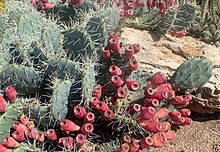Opuntia phaeacantha
| Opuntia phaeacantha | |
|---|---|

| |

| |
| Scientific classification | |
| Kingdom: | Plantae |
| Clade: | Tracheophytes |
| Clade: | Angiosperms |
| Clade: | Eudicots |
| Order: | Caryophyllales |
| Family: | Cactaceae |
| Genus: | Opuntia |
| Species: | O. phaeacantha
|
| Binomial name | |
| Opuntia phaeacantha | |
Opuntia phaeacantha is a species of prickly pear cactus known by the common names brown-spine prickly pear, tulip prickly pear, and desert prickly pear found across the southwestern United States, lower Great Plains, and northern Mexico. The plant forms dense but localized thickets. Several varieties of this particular species occur, and it may hybridize with other prickly pears, making identification sometimes tricky.
Description
[edit]Opuntia phaeacantha has a mounding habit of flattened green pads. The pads are protected by clusters of spines. Each cluster bearing 1-4 spines. The spines are brown, reddish-brown, yellowish, or gray, usually darker brownish toward the base than the tip, and often over 3 cm in length. At the base of the spine cluster is a round tuft of easily detached yellowish to reddish or brown bristles called Glochids. Glochids are also present on the fruit. This is the source for the plants common name "prickly pear".
The flowers are bright yellow with a pale green to orange or red center. In some regions occasional plants may produce flowers of other colors such as orange, pink, or magenta. The edible fruits are usually red or purple with a pink seedy flesh. The fruit has a mild watermelon or pear flavor. Both the fruit and the fleshy pads provide an important food resource for desert wildlife.
-
Typical yellow flower ►
-
Plant with light spine color and fruit
This plant, like other Opuntia species, is attacked by cactus moth.
Other common names for this species, and ones which are now considered variants of this species, include plateau prickly-pear, New Mexico prickly-pear, and Kingman prickly-pear.
The species is widespread, from California south to Mexico and the Southwest United States. There are multiple variations and perhaps these will be described as varieties or full species some day.[3]
Uses
[edit]The cactus can be prepared as food in a similar fashion to Opuntia humifusa.[4]
References
[edit]- ^ Terry, M., Heil, K., Gómez-Hinostrosa, C. & Corral-Díaz, R. 2017. Opuntia phaeacantha (amended version of 2013 assessment). The IUCN Red List of Threatened Species 2017: e.T152851A121613191. https://dx.doi.org/10.2305/IUCN.UK.2017-3.RLTS.T152851A121613191.en. Downloaded on 16 September 2021.
- ^ NatureServe (2024). "Opuntia phaeacantha". Arlington, Virginia. Retrieved 6 January 2024.
- ^ "Opuntia phaeacantha". Opuntia Web. 24 January 2012.
- ^ Elias, Thomas S.; Dykeman, Peter A. (2009) [1982]. Edible Wild Plants: A North American Field Guide to Over 200 Natural Foods. New York: Sterling. p. 140. ISBN 978-1-4027-6715-9. OCLC 244766414.
External links
[edit]- IUCN Red List least concern species
- NatureServe secure species
- Opuntia
- Cacti of Mexico
- Cacti of the United States
- Flora of Northwestern Mexico
- Flora of the Great Basin
- Flora of the Great Plains (North America)
- Flora of the Southwestern United States
- Flora of the California desert regions
- Flora of the Chihuahuan Desert
- Flora of the Sonoran Deserts
- Flora of California
- Flora of Kansas
- Flora of New Mexico
- Flora of Oklahoma
- Flora of the Sierra Nevada (United States)
- Flora of Texas
- Natural history of the California chaparral and woodlands
- Natural history of the Mojave Desert
- Flora of the Mexican Plateau
- North American desert flora
- Desert fruits




